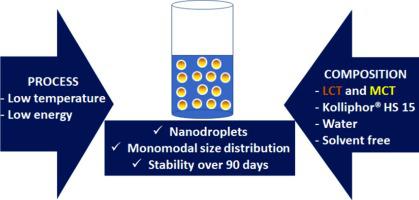Colloids and Surfaces B: Biointerfaces ( IF 5.8 ) Pub Date : 2020-10-27 , DOI: 10.1016/j.colsurfb.2020.111432 Yasmine Jamoussi 1 , Taghrid Zaiter 1 , Catherine Desrumaux 2 , Niyazi Acar 3 , Yann Pellequer 1 , Arnaud Béduneau 1

|
Oil-in-water nanoemulsions are used in numerous biomedical applications as delivery systems. The droplet size in the nanometer range and their composition were extensively developed for carrying and enhancing the absorption of lipophilic drugs and lipids of interest. In the present study, critical parameters involved in the spontaneous nanoemulsification process such as the temperature, the oil type, the surfactant-to-oil and water-to-oil ratios were investigated. The aim was to design a solvent-free procedure for the spontaneous nanoemulsification at a low temperature of a large variety of triglycerides including vegetable oils. Nanoemulsification of medium-chain triglyceride (MCT) was not dependent on the temperature while nanodroplets of long-chain triglycerides (LCT) were only obtained by reaching the cloud point of ethoxylated surfactant Kolliphor® HS15. The molar volume of triglycerides was considered as a predictive parameter governing both, the spontaneous nanoemulsification at low temperature and the Ostwald ripening rate. The physical mixture of MCT and LCT was a promising strategy to prepare stable and fine nanoemulsions at 37 °C. They were characterized by a hydrodynamic diameter comprised between 20 and 30 nm and a narrow size distribution. These findings pave the way to new applications for the parenteral nutrition and the delivery of thermosensitive drugs and lipophilic molecules such as antioxidants.
中文翻译:

中长链甘油三酸酯自发纳米乳化过程的研究
水包油纳米乳剂在许多生物医学应用中用作输送系统。为了携带和增强所关注的亲脂性药物和脂质的吸收,广泛开发了纳米范围内的液滴尺寸及其组成。在本研究中,研究了自发纳米乳化过程中涉及的关键参数,例如温度,油类型,表面活性剂与油的比例以及水与油的比例。目的是设计一种用于低温低温自发纳米乳化的多种甘油三酸酯(包括植物油)的无溶剂程序。中链甘油三酸酯(MCT)的纳米乳化不依赖于温度,而长链甘油三酸酯(LCT)的纳米液滴仅通过达到乙氧基化表面活性剂HS15的浊点而获得。甘油三酸酯的摩尔体积被认为是控制低温自发纳米乳化和奥斯特瓦尔德熟化速率的预测参数。MCT和LCT的物理混合物是在37°C下制备稳定且精细的纳米乳液的一种有前途的策略。它们的特征是流体动力学直径在20至30 nm之间,尺寸分布窄。这些发现为肠胃外营养以及热敏药物和亲脂性分子(例如抗氧化剂)的输送新应用铺平了道路。甘油三酸酯的摩尔体积被认为是控制低温自发纳米乳化和奥斯特瓦尔德熟化速率的预测参数。MCT和LCT的物理混合物是在37°C下制备稳定和精细的纳米乳液的一种有前途的策略。它们的特征是流体动力学直径在20到30 nm之间,尺寸分布窄。这些发现为肠胃外营养以及热敏药物和亲脂性分子(例如抗氧化剂)的输送铺平了道路。甘油三酸酯的摩尔体积被认为是控制低温自发纳米乳化和奥斯特瓦尔德熟化速率的预测参数。MCT和LCT的物理混合物是在37°C下制备稳定且精细的纳米乳液的一种有前途的策略。它们的特征是流体动力学直径在20到30 nm之间,尺寸分布窄。这些发现为肠胃外营养以及热敏药物和亲脂性分子(例如抗氧化剂)的输送铺平了道路。它们的特征是流体动力学直径在20到30 nm之间,尺寸分布窄。这些发现为肠胃外营养以及热敏药物和亲脂性分子(例如抗氧化剂)的输送铺平了道路。它们的特征是流体动力学直径在20到30 nm之间,尺寸分布窄。这些发现为肠胃外营养以及热敏药物和亲脂性分子(例如抗氧化剂)的输送新应用铺平了道路。



























 京公网安备 11010802027423号
京公网安备 11010802027423号